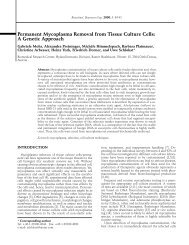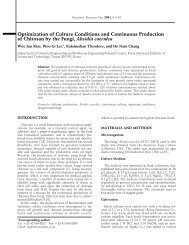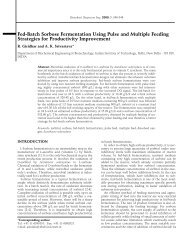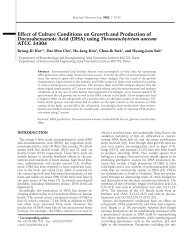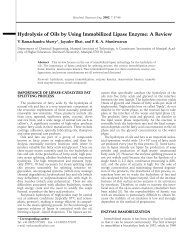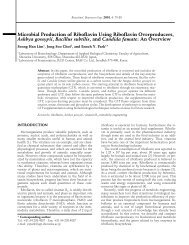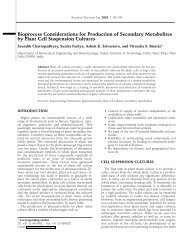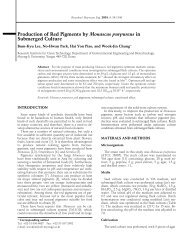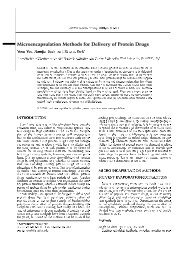Microencapsulation Methods for Delivery of Protein Drugs
Microencapsulation Methods for Delivery of Protein Drugs
Microencapsulation Methods for Delivery of Protein Drugs
You also want an ePaper? Increase the reach of your titles
YUMPU automatically turns print PDFs into web optimized ePapers that Google loves.
Biotechnol. Bioprocess Eng. 2001, Vol. 6, No. 4 223<br />
i.e., a therapeutic protein. However, <strong>for</strong> IG/PEC to<br />
uct,<br />
used <strong>for</strong> controlled delivery <strong>of</strong> protein entities, a cer-<br />
be<br />
type <strong>of</strong> dense membrane (e.g., biodegradable polytain<br />
preferably capable <strong>of</strong> controlling the release rate,<br />
mers),<br />
be incorporated or alternative combinations <strong>of</strong><br />
should<br />
should be explored to control the<br />
polyelectrolytes<br />
<strong>of</strong> the membrane, so that the release rate<br />
permeability<br />
be controlled over the desired span. Thus far, the<br />
may<br />
rate <strong>of</strong> the protein is likely to depend on the<br />
release<br />
properties <strong>of</strong> the model protein or the<br />
physicochemical<br />
medium in which the microparticles are placed<br />
release<br />
In case <strong>of</strong> alginate-poly-L-lysine system, all para-<br />
[71].<br />
are tied to a single chemical complex, there<strong>for</strong>e<br />
meters<br />
is not easy to optimize the capsule condition. For this<br />
it<br />
new combinations <strong>of</strong> polyelectrolytes were<br />
reason,<br />
to allow independent modification <strong>of</strong> capsule<br />
proposed<br />
including size, wall thickness, mechanical<br />
parameters<br />
permeability, and surface characteristics [99].<br />
strength,<br />
issue in IG/PEC is that some polyelectrolytes<br />
Another<br />
have biocompatibility problem. There have been<br />
might<br />
arguments concerning the biocompatibil-<br />
contradictory<br />
<strong>of</strong> alginates [100-102]. A host <strong>for</strong>eign-body reaction<br />
ity<br />
occurred on account <strong>of</strong> the implanted algi-<br />
(fibrosis)<br />
particles and mannuronic acid block was<br />
nate-based<br />
to be responsible <strong>for</strong> the fibrotic response, as a<br />
found<br />
stimulator <strong>of</strong> IL-1 and TNF-α production. Use <strong>of</strong><br />
potent<br />
<strong>of</strong> high guluronic acid content was suggested<br />
alginates<br />
minimize the cytokine response. On the other hand,<br />
to<br />
study indicated that alginate particles with<br />
another<br />
guluronic acid contents provoked stronger re-<br />
high<br />
than the high mannuronic acid alginate particles<br />
sponse<br />
In general, polyionic hydrogels obtained by<br />
[102].<br />
have rather low mechanical strength. A few<br />
IG/PEC<br />
have suggested ways to overcome this problem<br />
papers<br />
exploring alternative combinations <strong>of</strong> polyanions<br />
by<br />
polycations [87,99], introducing a different process<br />
and<br />
[103], or applying additional coating [82,98].<br />
INTERFACIAL POLYMERIZATION<br />
polymerization features in situ polymeri-<br />
Interfacial<br />
<strong>of</strong> reactive monomers on the surface <strong>of</strong> a droplet<br />
zation<br />
or particles.<br />
Method<br />
reactive monomers (typically dichloride and<br />
Two<br />
are respectively dissolved in immiscible sol-<br />
diamine)<br />
and mixed to <strong>for</strong>m o/w emulsion (dichloride in oil<br />
vents<br />
and diamine in water phase). The monomers dif-<br />
phase<br />
to the o/w interface where they react to <strong>for</strong>m a<br />
fuse<br />
membrane (Fig. 11). A typical example <strong>of</strong> this<br />
polymeric<br />
is making nylon microcapsules [104]. Nona-<br />
method<br />
phase (chloro<strong>for</strong>m/cyclohexane) containing surqueous<br />
(e.g., sorbitan trioleate) and aqueous buffer confactant<br />
drugs to be incorporated (enzymes or proteins),<br />
taining<br />
protein (e.g., BSA or hemoglobin) and dia-<br />
protective<br />
are prepared respectively. Two phases are mixed<br />
mine<br />
and stirred to make an w/o emulsion in an ice bath un-<br />
11. <strong>Microencapsulation</strong> by interfacial polymerization<br />
Fig.<br />
From reference [104].<br />
method.<br />
the desired droplet size is reached. Another nonaque-<br />
til<br />
phase containing acid chloride is added to the emulous<br />
<strong>for</strong> interfacial polymerization. Polymerization is<br />
sion<br />
by addition <strong>of</strong> excess nonaqueous phase.<br />
quenched<br />
are allowed to sediment and collected<br />
Microcapsules<br />
then washed in saline several times to remove or-<br />
and<br />
solvents and byproducts.<br />
ganic<br />
combinations <strong>of</strong> monomers can be used to<br />
Various<br />
a range <strong>of</strong> polymer membranes [104]. Sebacoyl<br />
obtain<br />
and 1,6-hexane diamine can be used to <strong>for</strong>m<br />
chloride<br />
polyamide nylon 6, 10. The microcapsules using<br />
the<br />
system, however, tend to be fragile and difficult to<br />
this<br />
Terephthaloyl chloride and 1,6-hexane diamine<br />
handle.<br />
yield polyester membrane. Alternatively tere-<br />
can<br />
chloride can be used in combination with Lphthaloyl<br />
to yield poly(terephthaloyl L-lysine). Typically<br />
lysine<br />
chlorides and diamines are reactive monomers;<br />
acid<br />
isocyanates can be used instead <strong>of</strong> or as a par-<br />
however,<br />
substitute <strong>for</strong> acid chloride [105]. Alternatively, the<br />
tial<br />
composed <strong>of</strong> only one type <strong>of</strong> monomer can be<br />
polymer<br />
on the interface (Interfaicial addition polymeri-<br />
<strong>for</strong>med<br />
[104]. Polyalkylcyanoacrylate belongs to this<br />
zation)<br />
Aqueous drug solution and oil phase containing<br />
type.<br />
monomer are mixed to <strong>for</strong>m an w/o<br />
cyanoacrylate<br />
The polymerization is initiated by water in<br />
emulsion.<br />
aqeous phase with cyanoacrylate dissolved in the oil<br />
the<br />
phase.<br />
Application<br />
Monomer B<br />
Monomer A<br />
Polymer membrane<br />
insulin nanoparticles were prepared using<br />
Recently<br />
addition polymerization techniques [106].<br />
interfacial<br />
were prepared by addition <strong>of</strong> ethyl 2-<br />
Nanoparticles<br />
to a stirred w/o microemulsion consistcyanoacrylate<br />
<strong>of</strong> aqueous insulin solution, oil and surfactant. To<br />
ing<br />
exhaustive washing steps after polymerization<br />
avoid<br />
biocompatible oils (caprylic/capric triglyc-<br />
reaction,<br />
and mono-/diglycerides) and surfactants (polyerides<br />
80 and sorbitan monooleate) were used to <strong>for</strong>sorbate<br />
the microemulsions. The obtained poly(ethyl 2mulate<br />
is known to be biodegradable. Since incyanoacrylate)<br />
was confined to the aqueous phase in w/o emulsulin <br />
sions, a high encapsulation efficiency (86%) could be





